Some Known Factual Statements About Legacy Orthodontics
Some Known Factual Statements About Legacy Orthodontics
Blog Article
Legacy Orthodontics for Dummies
Table of ContentsIndicators on Legacy Orthodontics You Need To KnowLegacy Orthodontics Can Be Fun For EveryoneGet This Report about Legacy OrthodonticsThe Best Guide To Legacy OrthodonticsLegacy Orthodontics Fundamentals Explained
In enhancement, we offer flexible treatment timetables, versatile payment alternatives and an enjoyable, satisfying experience.An orthodontist is a dental expert trained to diagnose, prevent, and deal with teeth and jaw irregularities. They remedy existing conditions and are trained to identify troubles that may create in the future. Orthodontists collaborate with people of all ages, from children to adults. People commonly connect an ideal smile with excellent health.
Malocclusion, or misaligned teeth, can cause dental concerns, including dental caries, gum condition, and tough or excruciating chewing. However not every person is birthed with straight teeth. If you have a poor bite or huge areas in between your teeth, you may wish to consult a dental professional specializing in orthodontic treatment.
Legacy Orthodontics Things To Know Before You Get This
( Photo Credit Scores: DigitalVision/Getty Images) Orthodontists utilize fixed and detachable dental tools, like braces, retainers, and bands, to transform the placement of teeth in your mouth. Orthodontic therapy is for dental irregularities, consisting of: Crooked teethBite issues, like an overbite or an underbiteCrowded teeth or teeth that are too far apartJaw misalignmentThe goal of orthodontic treatment is to enhance your bite.
A healthy and balanced bite guarantees you can eat, eat, and speak effectively. While you might think about orthodontists as mainly for children or teenagers that require dental braces, they can fix dental problems at any type of age. Orthodontists go to university, oral school, and orthodontic college. After graduation, they spend 2 or 3 years in an orthodontic residency program.
All orthodontists are dental professionals, however not all dentists are orthodontists. Orthodontic residency programs offer intensive, concentrated guideline for oral experts. They concentrate on 2 areas: How to effectively and securely move teeth Just how to appropriately assist advancement in the teeth, jaw, and faceOnce an orthodontist has actually finished training, they have the alternative to end up being board licensed.
The Of Legacy Orthodontics
Imbalance, or malocclusion, is the most usual reason people see an orthodontist. It is genetic and is the outcome of dimension distinctions in between the top and lower jaw or in between the jaw and teeth. Malocclusion results in tooth congestion, a twisted jaw, or uneven bite patterns. Malocclusion is usually treated with: Your orthodontist affixes steel, ceramic, or plastic square bonds to your teeth.
If you have just small malocclusion, you may have the ability to use clear dental braces, called aligners, instead of standard dental braces (https://myspace.com/legacyortho). Some individuals need a headwear to help move teeth into line with stress from outside the mouth. After braces or aligners, you'll need to put on a retainer. A retainer is a custom gadget that keeps your teeth in position.
They're frequently made use of on children. They can produce added space in the mouth without needing to draw teeth. If you have a major underbite or overbite, you may require orthognathic surgical procedure (also called orthodontic surgical treatment) to lengthen or reduce your jaw. Orthodontists utilize wires, medical screws, or plates to sustain your jaw bone.
You might require to see an orthodontist if you have: Crowding or otherwise adequate area for every one of your teethOverbite, when your upper teeth come over your base teethUnderbite, when your bottom teeth are too much forwardSpacing or concerns with gapsCrossbite, which is when your upper teeth fit behind your base teeth when your mouth is closedOpen bite or an upright space in between your front base and upper teethMisplaced midline, when the center of your base and top teeth don't line up Fixing a dental malocclusion can: Make attacking, chewing, and talking easierImprove the proportion of our face and your general appearanceEase pain from temporomandibular joint disordersDifferent your teeth and make them less complicated to clean up, helping avoid dental cavity or cavities It's typically a dentist who initially notices misaligned teeth throughout a regular test.
Not known Details About Legacy Orthodontics

During your very first about his orthodontic examination, you'll likely have: A dental examPhotos taken of your face and smileDental X-raysPanoramic (360 level) X-rays of your face and headImpressions to create molds of your teethThese tests will certainly help your orthodontist understand exactly how to proceed with your therapy. leesburg orthodontist. An orthodontist is a dental expert who's had training to treat your teeth and jaw
An orthodontist is focused on your bite, so something like a chipped tooth would be dealt with by a dental professional. Orthodontists are focused on your bite, or the method your teeth fit together, and the straightness of your teeth.
Ever before questioned exactly how celebrities always appear to have perfectly straightened teeth? The solution commonly lies in the proficient hands of an orthodontist. However just what does an orthodontist do? Orthodontists are oral specialists who concentrate on dealing with abnormalities in the teeth and jaws. Their competence goes past just developing a beautiful smile; it includes boosting your overall oral health and function.
The Main Principles Of Legacy Orthodontics

, orthodontists have a varied toolkit at their disposal. These tried-and-true dental braces use a system of brackets bonded to the teeth and linked by cords.
These removable trays are tailor-made to progressively shift the teeth's position. In situations of narrow jaws, palatal expanders can be used to develop area for correct tooth positioning.
Report this page